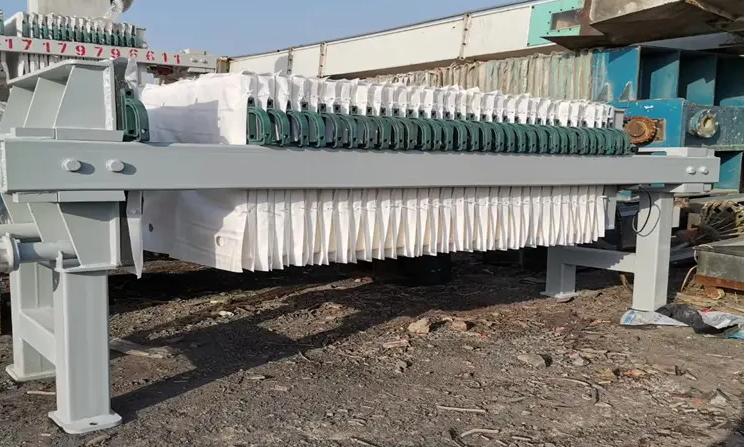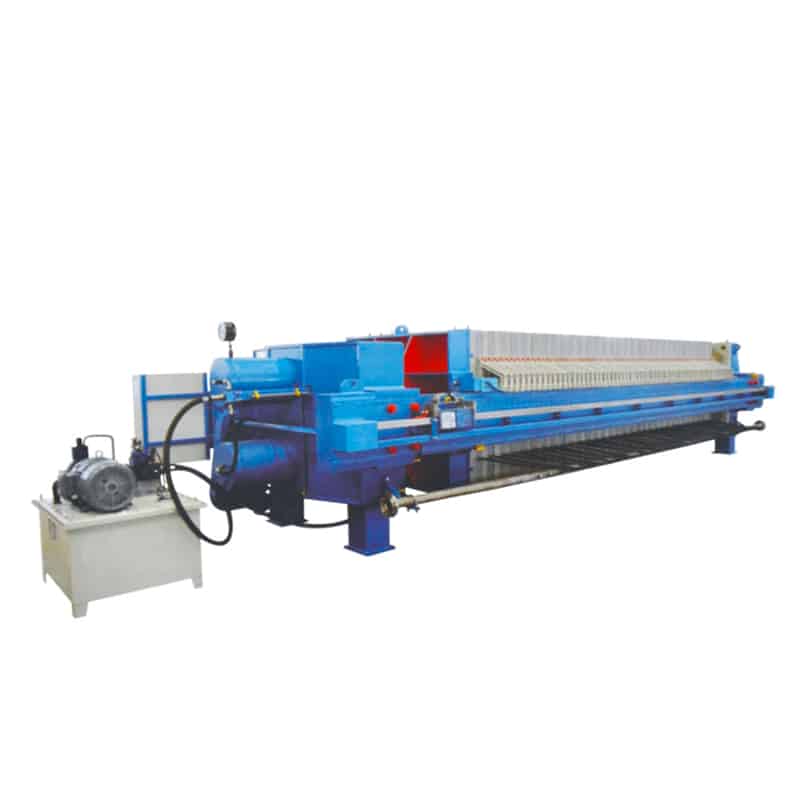Overhead beam filter presses (OHBFs) are industrial filtration equipment for liquid-solid separation and dewatering. They consist of an upper beam from which a set of plates is suspended. These plates are grooved on both sides and can optionally include fixed or removable membranes for further liquid removal.

Working Principle for Overhead Beam Filter Presses
- Slurry feed: The slurry to be dewatered is pumped into the filter plate chamber formed by the grooved plates.
- Plates: Hydraulic pressure is used to press the plates together, forcing the liquid through the filter cloth covering the plates and out of the filter press.
- Cake formation: Solids are trapped on the filter cloth to form a cake.
- Cake discharge: After the filtration cycle is complete, the plates are opened and the cake is discharged from the filter press.
Advantages of Overhead Beam Filter Presses
- High dewatering efficiency
- Versatility
- Durable construction
- Easy maintenance
Applications
The overhead beam filter press is employed in various industries due to its robust design and efficient performance:
- Mining and Mineral Processing
In the mining industry, this filter press is used to dewater mineral concentrates and tailings, ensuring the recovery of valuable resources and the safe disposal of waste materials. - Chemical Processing
Chemical plants utilize overhead beam filter presses for the filtration of chemicals, catalysts, and other process intermediates, ensuring product purity and process efficiency. - Wastewater Treatment
Municipal and industrial wastewater treatment facilities use these filter presses to remove solids from sludge, producing clear filtrate and reducing sludge volume for disposal. - Food and Beverage Industry
In the food and beverage sector, overhead beam filter presses are used for the clarification and purification of liquids, such as fruit juices, wine, and edible oils.
Comparison of Side Beam and Overhead Beam Filter Presses
| Characteristics | Side Beam | Overhead Beam |
| Framework | Located on the side of the filter plate | Located above the filter plate |
| Processing capacity | Small | Large |
| Maintenance Costs | Low | Large |
| Slurry | Small to medium volume, low viscosity, low solids concentration | High volume, high viscosity, high solids concentration |
| Applications | Food, beverage, paper, printing and dyeing, etc. | Mining, metallurgy, chemical, pharmaceutical, etc. |
Types of Overhead Beam Filter Press
Automated overhead beam filter press
The automated top beam filter press is equipped with an automatic control system that automatically completes all operations in the filter press process, reducing manual intervention, ensuring consistency in each filter press cycle, and improving production efficiency. Suitable for industrial fields that require high efficiency and precision filtration, such as chemical, pharmaceutical and food processing.
Semi-Automatic Overhead Beam Filter Press
Usually the more automated parts are cake unloading and filter cloth cleaning, other operations may require manual intervention. It is suitable for small and medium-sized enterprises or industrial occasions that require flexible operation, such as medium-sized effluent treatment plants.
High Pressure Top Beam Filter Press
High Pressure Top Beam Filter Presses are capable of withstanding higher operating pressures (typically in the range of 15-30) in order to achieve higher filtration efficiencies and lower moisture content of the filter cake.
Diaphragm Overhead Beam Filter Press
Diaphragm Top Beam Filter Press adds diaphragm between the filter plate and the filter cloth, which is able to press the filter cake further by inflation or liquid pressurization, thus improving the dewatering efficiency. It is suitable for industries that require very low moisture content filter cake, such as chemical, pharmaceutical and food processing.

Although both have a diaphragm press function, where secondary pressing is accomplished by expansion of the diaphragm, diaphragm overheaf beam filter presses are constructed with a top beam to provide better accessibility and stability, whereas ordinary membrane filter presses are usually constructed with side beams.
Small Overhead Beam Filter Press
Small Overhead Beam Filter Presses are compact in design and are suitable for use in laboratory or small scale production environments. It is widely used in laboratory research, process development and small-scale production.
Maintenance Tips
To ensure the optimal performance and longevity of an overhead beam filter press, regular maintenance is essential.
- Routine Inspection: Regularly inspect the filter plates, cloths, and hydraulic system for signs of wear or damage.
- Filter Cloth Cleaning: Clean the filter cloths thoroughly after each filtration cycle to prevent clogging and maintain filtration efficiency.
- Lubrication: Ensure all moving parts, such as the hydraulic cylinders and plate shifting mechanisms, are adequately lubricated.
- Leak Detection: Monitor for any leaks in the hydraulic system and repair them promptly to prevent pressure loss and operational inefficiency.
- Replacement of Worn Parts: Replace worn or damaged components, such as filter cloths and seals, to maintain optimal performance and prevent breakdowns.
Summary
The overhead beam filter press is a vital piece of equipment in various industrial processes, offering numerous benefits such as enhanced accessibility, operational efficiency, and durability.
In modern industry and environmental protection, the innovation and application of water treatment technology is particularly important. kuosi water treatment manufacturers, as leaders in the industry, have won wide acclaim for their outstanding technical strength, extensive experience and first-class product quality. Contact us for your solutions.
